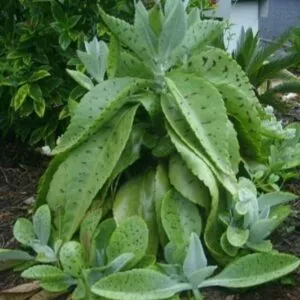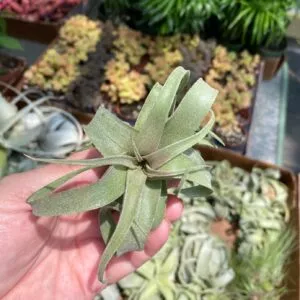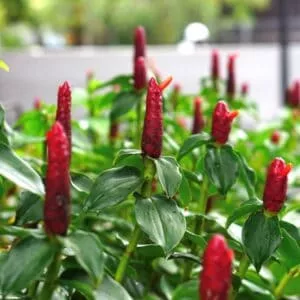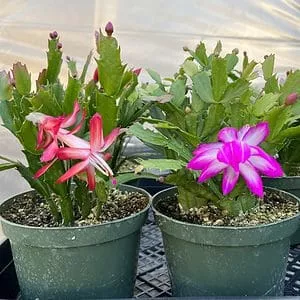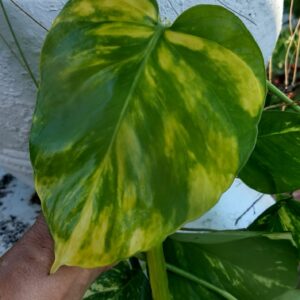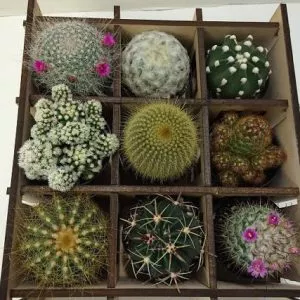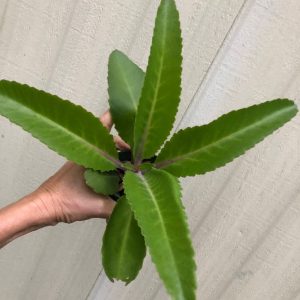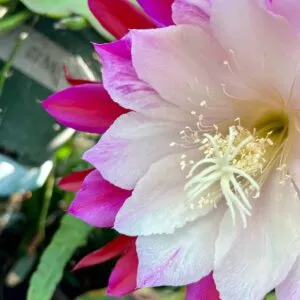No products in the cart.
Table of Contents
Want to make your garden look likes a seawater collection? Well, have another plant that looks like a fish’s or whale’s fin. This mermaid tail succulent plant is the perfect fit for that. These plants, typically one to two feet tall and three to five feet broad, resemble a mermaid or whale fin.
They also bring tremendous underwater marine sensations into your home. The bluish-green tint of the plant complements any room with a neutral color scheme or an ocean motif! Which is perfect as an indoor plant, of course!
And did you know that this unique plant is the polar opposite of most succulents? Why? It is because they thrive in winter and is dormant in the summer! And most other succulents, on the other hand, are the opposite.
The flattened stem can be seen around the rising point if you look closely enough. This is why the plant’s emerging leaves are short and bloated. Stems appear fused together at the bottom and expanded out at the top, giving the crested coral cactus succulent its appearance.
The bent shoots produced by this process provide the succulent mermaid tail with its crest. Does this mermaid tail already catch your attention? I’m sure it did. And you are lucky to be here because we’re here to tell you how to take care of such beauty.
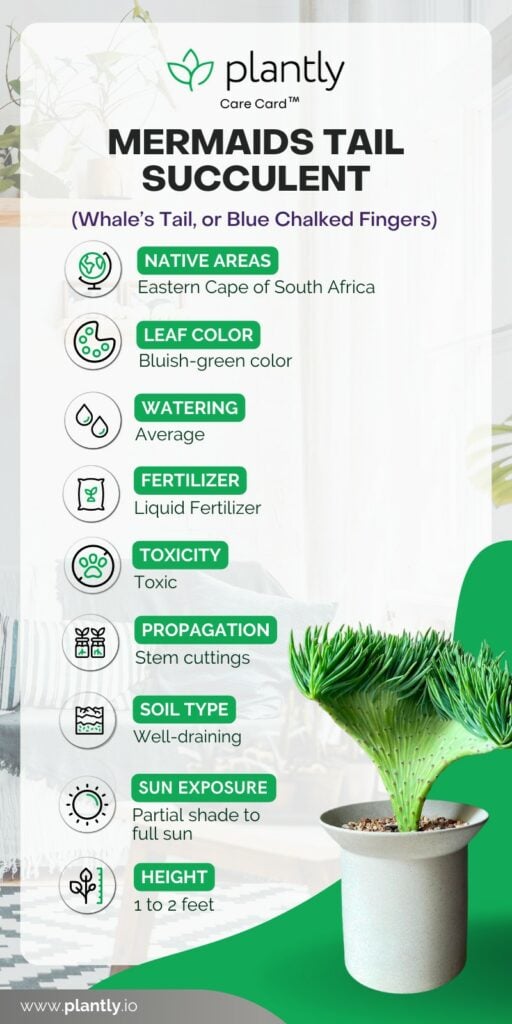
Read below to find out more!
Mermaids Tail Succulent Plant Care Basics
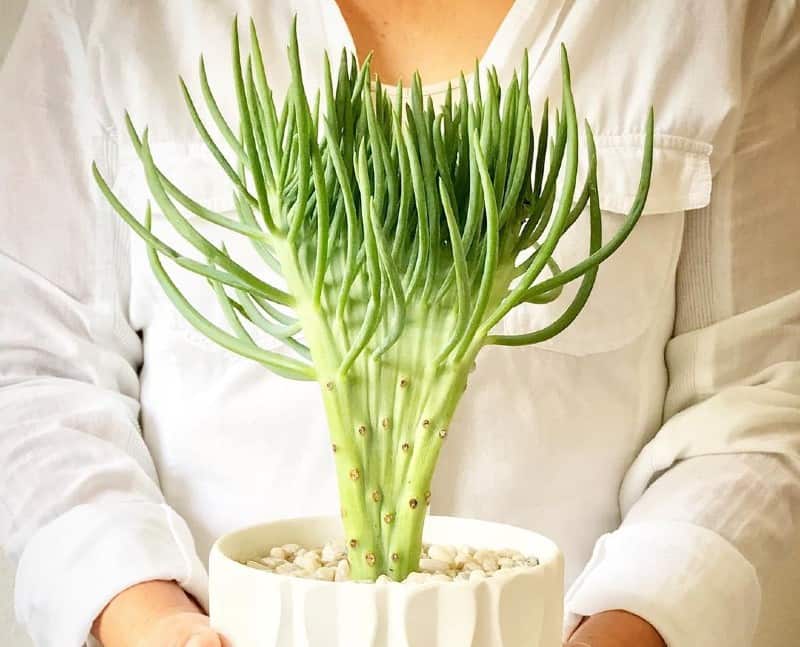
Before that, here’s a little overview of this Mermaid’s tail.
Now that you are already familiar with these Mermaid tails, let us move on to learning how to take care of this coral cactus. Enjoy reading!!
Recommended Potting mix
The Mermaid Tail grows and thrives best in well-draining soil because its roots are particularly susceptible to fungus infections and rotting. This plant thrives in porous sandy soil, such as cactus potting soil or sand, and an unfertilized soil mix. The soil will be better for the plant if it is organic and devoid of fertilizers and chemicals.
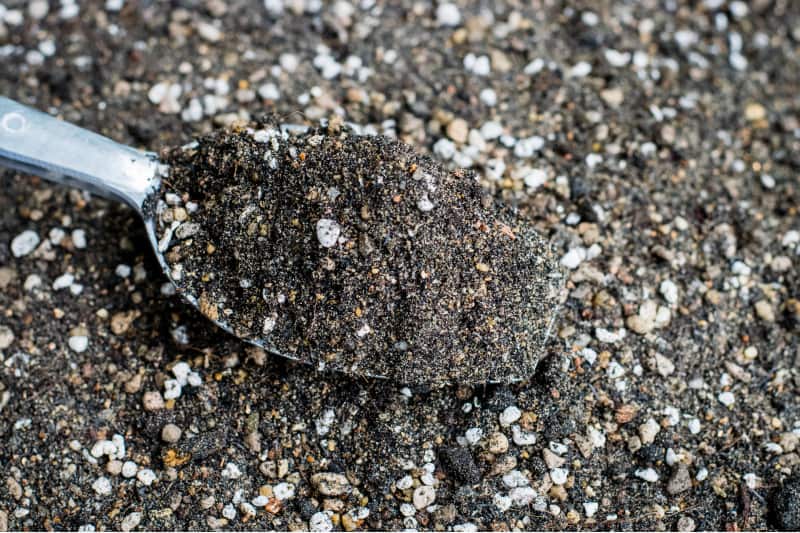
The Mermaid tail can also grow in a wide range of pH conditions, from acidic to alkaline.
Lighting Requirement
In both partial shade and direct sunlight, the Senecio Vitalis thrives beautifully. This sun-loving plant is hardy and can withstand the hot midday sun. Still, if you live in a warm region, you should keep it out of the afternoon sunlight as much as possible to avoid the sun burning its leaves.
It’s ideal to please it somewhere outside where they can get at least 6 hours of sun per day.
Pro tip: Place your Mermaid Tail near an east-facing or south-facing window when growing it indoors.
Watering Needs
During its immature stages, this Mermaid tail should be watered daily. After that, depending on how well the soil drains excess water, you can water it every two to three days. Before watering your plant, make sure the top coat of the soil is absolutely dry.
In stock In stock (can be backordered) In stock In stock
Free Shipping
$19.99
Sold By:
D&D simplicity products
Succulent Arrangement in Mini Cat Planter
Sold By:
D&D simplicity products
Free Shipping
$19.99
Sold By:
Gar-Zen Botanical Design
Kalanchoe Gastonis bonnieri Donkey Ear Ships Free.
Only 7 available and it’s in 2 people’s basket Rated 4.86 out of 5 based on 49 customer ratings00
Sold By:
Gar-Zen Botanical Design
$25.00
Sold By:
That Wild Yard
Rare Plumeria, Madame Poni, 15+ in cutting
Sold By:
That Wild Yard
$10.00
Sold By:
Smoot's Farm
Air Plant Shirley Temple
Only 11 available and it’s in 2 people’s basket Rated 4.89 out of 5 based on 27 customer ratings00
Sold By:
Smoot's Farm
Remember that having enough soil increases the importance of water flowing in. Also, don’t let the pot sit on a water saucer.
Pro tip: Because your Senecio Vitalis can tolerate droughts, it’s a perfect plant for those who don’t have a lot of time to care for plants but still want to appreciate their beauty.
Ideal Temperature & Humidity
Although these succulents enjoy sunlight, it does not thrive in severely hot or cold temperatures. It can grow in mild to hot and dry conditions and has the lowest temperature range of 30 to 40 degrees Fahrenheit (-1 to 4 degrees Celsius). Mermaid Tail Succulents can also withstand freezing temperatures. Because it is a winter grower, it is dormant during the summer.
Avoid exposing the Senecio Vitalis to frost or humidity. Humidity can cause the leaves to decay, while frost can cause the water inside the leaves to freeze, splitting and scorching them and leaving a scar.
Necessary Fertilizer
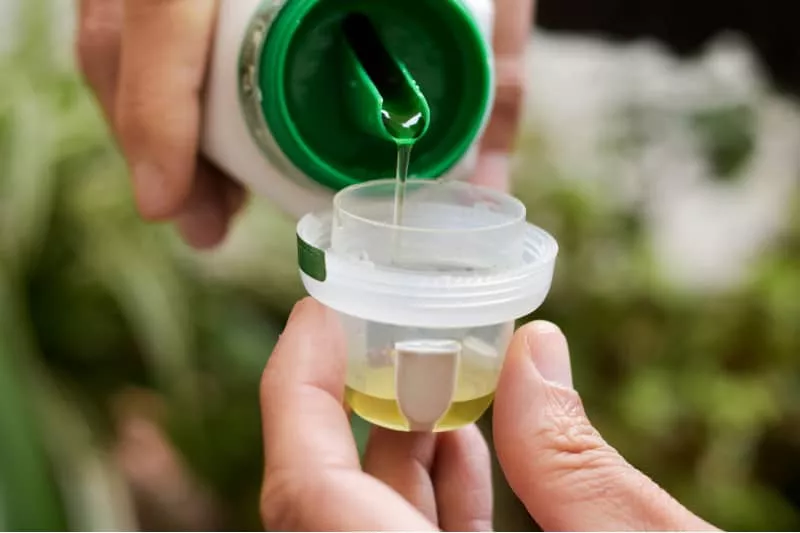
Fertilizer isn’t that required for your Mermaid Tail. However, if you want to feed them to fully grow, you may give the plant half-strength liquid fertilizer if it’s being developed in a pot and indoors. Before providing your plant, dilute the fertilizer three or four times, and always follow the instructions!
Pro tip: Your Mermaid’s Tail does not require fertilizer if grown on the ground.
Propagation
Ready to propagate your Mermaid’s tail? Although the Mermaid Tail is a mutation and considered a rare plant, there is no certainty that the new plant will appear like its mother plant when propagated. But! You may wind up with your own collection of these storybook princesses!
So, here’s how you will propagate them:
- Cut a leaf from the plant with a sterilized knife. Wear gardening gloves when handling this succulent plant because it is poisonous.
- Allow it to callus for a few days before planting. Allow the new plant to acclimate to its new surroundings by not watering it for a few days.
- Plant the cutting in fresh soil that is well-draining and water it every day until the root system appears.
Growth Zone

The hardiness zone for this Senecio Vitalis ranges from 10a to 11b, with temperatures ranging from 30 degrees Fahrenheit (-1.1 degrees Celsius) to 50 degrees Fahrenheit (10 degrees of Celsius). If you live in a climate that most of the time resembles USDA zones 10 to 11, you may still grow this plant outside and bring it inside when the weather becomes too harsh for it.
Potting and Pruning
Mermaid tail prefers a large, shallow container with plenty of areas for its horizontal rhizome to grow. A hollowed-out portion of the tree fern trunk or a wire-hanging planter with a coir fiber liner might also work.
To control the height and spread of your Mermaid Tails, you may prune them. Pruning should be done every year before the growing season begins.
Only 20 left in stock (can be backordered) In stock Only 4 left in stock (can be backordered) In stock
Free Shipping
$25.99
Sold By:
Gar-Zen Botanical Design
Indian Head Ginger Costus woodsonii Ships Free
Only 20 available and it’s in 2 people’s basket Rated 4.86 out of 5 based on 49 customer ratings00
Sold By:
Gar-Zen Botanical Design
$26.99
Sold By:
Cacti and Exotica
Schlumbergera — Christmas cactus
Rated 4.98 out of 5 based on 59 customer ratings00
Sold By:
Cacti and Exotica
Free Shipping
$19.99
Sold By:
Gar-Zen Botanical Design
Pothos Giant Golden 2 Cuttings Ship Free
Only 4 available and it’s in 1 people’s basket Rated 4.86 out of 5 based on 49 customer ratings02
Sold By:
Gar-Zen Botanical Design
$73.99
Sold By:
Succulent Oasis
Shadow Box Nine Cacti Planter
Rated 4.84 out of 5 based on 352 customer ratings00
Sold By:
Succulent Oasis
Mermaids Tail Succulent Varieties and Similar Plants
Not satisfied in just one Mermaid tail plant? Don’t worry because some look like this beauty, and we’re here to tell you some of them! And I know at first glance you will be mesmerized and want to grow it as well.
Here are some of them:
- Euphorbia lactea Cristata
Euphorbia lactea ‘Cristata’ has fan-shaped branches that develop in an almost undulating pattern, giving it a unique appearance. The stem and branches might be bright green, blue-gray, or even silver in appearance. The edges of the wavy branches might even become pink when they are stressed.
- Senecio peregrinus
Senecio’ Hippogriff,’ also known as Curio x peregrinus or Senecio x peregrinus, is a lovely succulent with leaves that resemble little dolphins leaping from the surf. As the leaves mature, they become increasingly identical, forming an excellent potted plant.
- Senecio Vitalis
With its cylindrical gray-green leaf, Senecio Vitalis (Narrow-Leaf Chalksticks) is a spreading evergreen succulent with considerable decorative appeal. Its 3-5 inches leaves are thin and slightly upcurved. They’re glaucous-gray and finger-like, and they’re lengthy (7-12 cm). They produce attractive tufts at the stem tips and wrap the trailing stems.
Mermaids Tail Succulent Plant Diseases & Pests
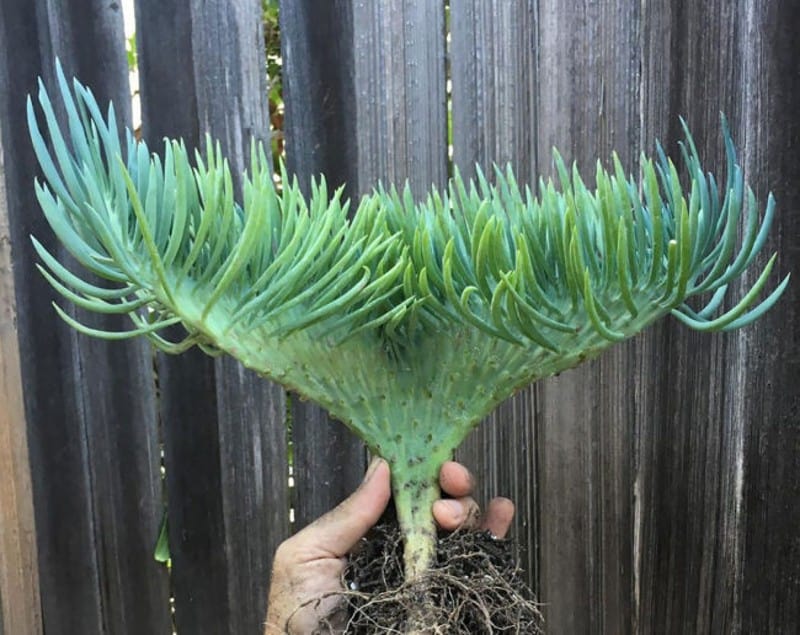
Aphids, scale, and mealybugs may harm the Mermaid tail, as they do many other ferns. Physical removal is the best technique to get rid of them, but apply horticultural oil if that isn’t possible. To find out what strength to use on ferns, always read the directions!
Root rot and fungal infections are also common problems for Mermaid Tails. Overwatering is a common cause of these problems. Using the soak and dry approach, you may avoid overwatering.
If your plant’s soil does not drain well, repot it in well-draining soil. The most aggravating aspect of root rot is that you will most likely be unaware that your plant is infected until it is too late. However, you can save them when you see that the plants wilt or become ‘mushy’ and they discolor and turn a dull yellow or brown color.
Frequently Asked Questions
Crested Senecio Vitalis is the scientific name/real name/official name of this beautiful succulent
Yes, they can be poisonous. They can also be hazardous to animals, so pet owners should be cautious (and humans).
Yes! This type of succulent is considered to be a rare plant. The factor which contributes to being rare is that this plant is a mutation.
Although rare, you can now buy this gorgeous beauty here at Plantly! We offer faster transactions online and will deliver the plant safely! Message us now!!
Whether you want to buy, sell or simply reach out to other plant enthusiasts, Plantly is the right place to be!
-
$15.99Sold By: BubbleBlooms
In stock
Philodendron Birkin, 4 inch, White Wave, Mermaid’s Tail
Only 93 available and it’s in 1 people’s basketRated 4.81 out of 5 based on 279 customer ratings01Sold By: BubbleBlooms -
$12.95Sold By: SunSoul Plants
In stock
LIVE kalanchoe suarezensis plant potted with soil in 3″ pot
Only 1 available and it’s in 1 people’s basketRated 4.87 out of 5 based on 98 customer ratings00Sold By: SunSoul Plants -
$9.99Sold By: Succulent Oasis
In stock
Small Cactus Plant Old Man of the Andes.
Only 7 available and it’s in 1 people’s basketRated 4.84 out of 5 based on 352 customer ratings00Sold By: Succulent Oasis -
$35.00Sold By: That Wild Yard
In stock
Clown Epiphyllum Plant, Orchid Cactus
Sold By: That Wild Yard

